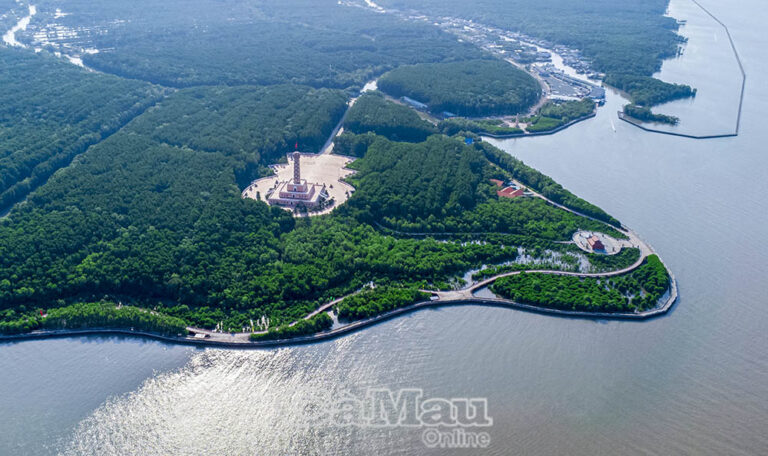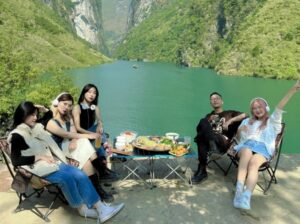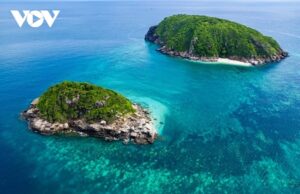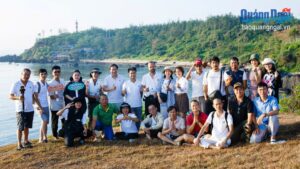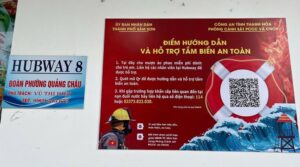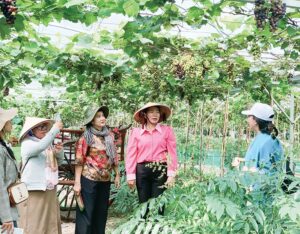We set foot on Cu Lao Re (the ancient name of Ly Son Island District, Quang Ngai Province) right on the opening day of the boat racing festival (taking place from the 4th to the 7th day of the Lunar New Year). This festival is considered the largest among the coastal residents of Quang Ngai as well as the South Central region in general.

The smiles of visitors to Ly Son Island.
Along the coastal road, hundreds of colourful umbrellas bobbed as people shielded themselves from the sun while cheering. Offshore, at exactly 11:30 AM, the tide began to rise, lapping against the race marker flags. The cheers and the sound of horns mimicking the call of the Oc U shell resounded, bringing vibrant energy to this frontline island of the homeland. The rolling clouds and foaming waves before our eyes were not just a natural spectacle of the island but also a legendary guide, leading mainland visitors to a deeper understanding of the geological, historical, and cultural journey of Ly Son.
Settling in the layers of cultural confluence
An Hai Communal House - its greyish and moss-covered roof bearing the marks of time - stands as a testament to the passage of history. Sand blankets the courtyard and gathers at the feet of nghe (Vietnamese unicorns). As a nationally recognised historical site, this communal house embodies the cultural fusion of the Cham and Vietnamese traditions. Since its initial construction in the 19th century, it has undergone six restorations, each one adding to its solemn and timeworn presence. Nguyen Lineage caretakers have watched over this place for 25 years, preparing for the boat racing festival. One of them shares with me that An Hai Communal House venerates Ngu Ma Nuong (the Holy Mother), also known as Poh Yang Ina Nagar to the Cham and Thien Y A Na to the Vietnamese. The goddess Poh was born from the union of sea foam and the clouds above the vast ocean.
Each step on this island unveils a dense presence of historical relics including communal houses, pagodas, temples, shrines, mausoleums, ancestral halls, and ancient wells, many of which were built centuries ago on archaeological sites dating back thousands of years to the Sa Huynh Culture. The island’s coastal identity is reflected in these structures, which are adorned with vibrant colours, with dominant hues of blue and intricate wave motifs stretching endlessly. A striking springtime image on the island is the vibrant red of the national flags adorning homes, alleyways, and historic sites. Notably, in Ly Son, the national flag is often displayed at the centre of structures, just below the roof, at the front porch - creating a stunning backdrop of red and gold that radiates warmth and pride in this island setting.
Nestled in Dong Village, An Hai, a branch ancestral hall of the Pham family stands out with its wooden structure, built in the 1960s. The national flag, displayed prominently in the centre, adds to its striking presence in the village. A grandson carefully sweeps the last bits of dust from the porch, while inside the left chamber, his grandfather fumbles with the buttons of his Ao Dai, preparing in time for the hoa vang (joss paper burning) ceremony to bid farewell to the ancestors.
Pham Nha from a branch of the Pham Lineage said that while the main Pham Lineage’s worship house is large, the halls of the Lineage’s branch like this one are more modest. Beyond being worship places, the houses in Ly Son, arranged along sloping paths and narrow alleys, create a unique island settlement. Each colour and architectural detail seems to whisper stories of deep-rooted cultural exchanges.
In front of many homes, cay neu (New Year poles) are adorned with phung (phoenix) or ca chep (carp) ornaments, carrying on the ancient ritual of thuong dieu nghinh xuan - a tradition meant to ward off evil spirits and welcome a peaceful new year. Yet, what truly captivates me is the mesmerising shade of ocean blue that colours the doors, fences, walls, and even the curtains. This hue is not just a decorative choice, it is an iconic element of Ly Son’s cultural heritage - a colour that echoes the timeless embrace of the sea surrounding Cu Lao Re.
So many questions arise. Like when I stumble upon the Oc Hamlet and Chinh Stream archaeological sites, nestled in Ly Son’s farmlands, bearing witness to a civilisation that thrived some 3,000 years ago. I recall the earthenware jars, ceramic bowls, stone tools, and shell implements that have been unearthed here — artifacts now displayed at the Quang Ngai Provincial Museum - revealing the astonishing ingenuity of the island’s ancient inhabitants.
The island’s way of life holds an irresistible allure. Every element of its landscape, history, and culture weaves together a narrative of this storied land - the birthplace of the Hoang Sa Flotilla. Even today, mo gio (graves without the bodies of the deceased), temples, and pagodas stand as solemn memorials, honouring those who once braved the vast sea in defence of the nation’s sovereignty.
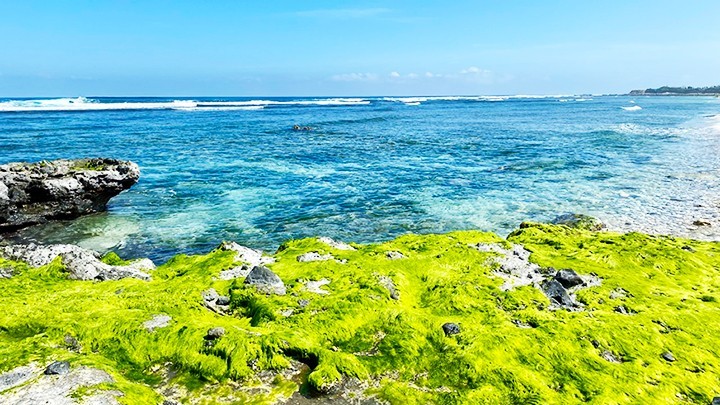
The season of moss on Ly Son Island.
Keeping the sea and islands green
Perhaps every islander is, in their own way, a guardian of the sea and land. Indeed, the life they cultivate is more than just a means of survival. Their struggle against the waves is not merely an occupation. From distant shores, the lullabies of grandmothers and mothers, the rhythmic drumbeats of the boat racing festival, and the solemn chants of the Le Khao le the linh Hoang Sa (Feast and Commemoration Festival for Hoang Sa Soldiers) all echo a deep call, binding the people of Ly Son to their homeland in the most natural way.
Trung, born in 1988, now drives an electric vehicle on the island. As a member of the Le Lineage in An Vinh, he started fishing at the age of 16 and has worked in the waters of Hoang Sa and Truong Sa. He recalls how, out there, the sea tosses wooden fishing boats up and down relentlessly. Fishermen can’t just lie still, so they need a wooden beam to brace yourself, to wedge yourself in place. October and November bring the roughest seas, yet whenever it is possible to sail, they go. The fishing boats, with wooden hulls weighing 60-70 tonnes, mainly catch ca bac ma (Indian mackerel) and ca nuc (round scad). He added that most fishermen here rely on luoi vay dem - the nighttime purse-seine fishing technique widely practiced by Vietnamese seafarers.
Speaking of Ly Son, one cannot forget its vast garlic fields. On some early mornings, mist rolls in from the mountains, blanketing the fields like a soft and white veil. Watching the delicate mist drift in, one might momentarily wonder: could it be pesticide? But after a frantic inquiry with a farmer across the road, the answer is clear: it is simply morning fog!
The fields are about a month away from harvest, with garlic stalks standing over 40 centimetres tall. At dawn, the automatic irrigation system begins its rhythmic work, creating a mesmerising sight. The soil, unlike anywhere else, is covered with a layer of white sand, speckled with traces of marine molluscs. This land, where garlic thrives, is a remarkable blend of ocean and earth - a unique fusion shaped by Ly Son’s island geography. Beneath the surface, layers tell a story of time: deep below lies clayey soil, the aftermath of volcanic eruptions 25-30 million years ago. Above that, a layer of decomposed vegetation enriches the land as natural fertiliser; and on top, the iconic sand mixed with seashells nurtures the island’s famous garlic. The green garlic plants stand against the stark white sand, while the surrounding volcanic rocks - in shades of brown, grey, black, and ashen hues - bear coral-like patterns. It is a natural masterpiece, beyond words.
Ly Son Island has around 320 hectares of garlic fields, yielding approximately 2,800 to 3,000 tonnes of fresh garlic annually. Recently, organic garlic farms have also emerged, aiming to produce higher-value crops for local farmers. However, these 300 hectares of garlic fields do not always guarantee a bountiful harvest. The sea provides nutrients but also brings many challenges.
Duong Thi Lai, a farmer from An Hai with about 2,500 square metres of garlic fields, shared that this year’s harvest is good, but in bad years, storms and strong winds can wipe out entire crops. Indeed, the powerful sea winds, especially during typhoons, pose a constant threat. According to engineer Nguyen Van Loi from the Ly Son Hydro-Meteorological Station, typhoons with gusts reaching level 14 (equivalent to over 150 kilometres per hour) are not uncommon in the area.
These layers of earth and sea sand, the foaming waves and drifting clouds, embody the continuous cycle of life - growing, renewing, and thriving endlessly. These unceasing cycles of creation and regeneration enrich the essence and beauty of this frontier island of the homeland. They are also the deeply rooted foundation for preserving and safeguarding the nation's seas and skies.
Giang Cao - Translated by NDO


